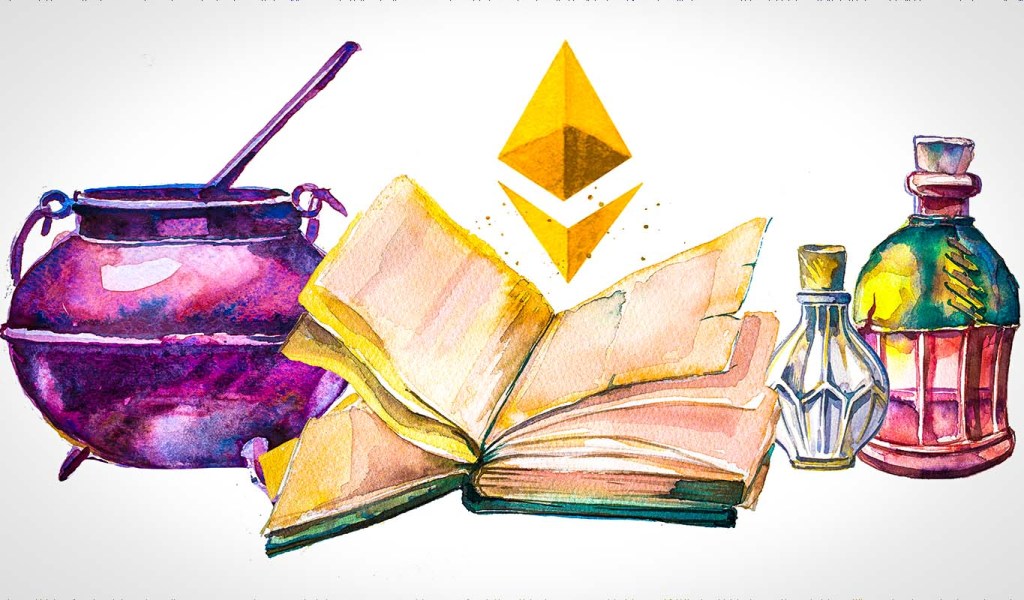
Real Vision CEO Raoul Pal says that Ethereum’s (ETH) transition to proof-of-stake will bring something “magical” to the top smart contract platform. In a new interview on Real Vision Crypto, the macro guru says that investors will flock to Ethereum after it transitions because yield will be introduced to the protocol. Pal notes this is […]
The post Ethereum Will Introduce Something Magical After the Merge, Says Macro Guru Raoul Pal – Here’s What He Means appeared first on The Daily Hodl.

The Ethereum blockchain is set to bid farewell to proof-of-work, and welcome proof-of-stake as the mainnet merges with the Beacon Chain.
Ethereum's long-awaited transition from proof-of-work (PoW) to proof-of-stake (PoS) is upon us as the Merge looms in less than 10 hours. There's plenty to consider for the wider cryptocurrency space — and here's what you need to know.
The Ethereum blockchain will transition away from its energy-intensive consensus mechanism PoW as its execution layer merges with the new PoS consensus layer known as the Beacon Chain.
The Beacon Chain went live in December 2020, allowing ecosystem participants to deposit or "stake" ETH to become the new validators of the network, in doing so replacing PoW miners that had previously put in the work to process transactions, produce blocks and secure the network.
In its simplest form, the Merge will make the Ethereum network use 99% less energy and provide greater scalability, security and sustainability.
Ethereum’s mainnet (PoW) and the Beacon Chain (PoS) have been running concurrently and will finally merge — hence the name — ushering in a new era for the smart contract blockchain network. The entire transaction history of Ethereum will be carried across as the new consensus mechanism takes control of the network.
As explained, users that are able to stake a total of 32 ETH are eligible to become individual validators of the Ethereum Beacon Chain. Validators are assigned to produce blocks at random and validate transactions and blocks created by other validators in the network.
Users can also take part in pooled or centralized staking pools by staking smaller amounts of ETH, which promises a share of rewards for validating and maintaining the network. There are multiple staking options to consider for those interested in playing a part in the network's new consensus mechanism.
A recent report from blockchain analytics platform Nansen shows that just over 11% of the total circulating ETH is staked, with 65% liquid and 35% illiquid. There are a total of 426,000 validators and some 80,000 depositors, while a small group of entities commands a significant portion of staked ETH.
Three major cryptocurrency exchanges account for nearly 30% of staked ETH, namely Coinbase, Kraken and Binance. Lido DAO, the biggest Merge staking provider, accounts for the largest amount of staked ETH with a 31% share, while a fifth unlabelled group of validators holds 23% of staked ETH.
As Cointelegraph previously reported the Merge will see ETH, the native currency of the Ethereum ecosystem, remain once the mainnet joins the Beacon Chain. It is worth noting that some PoW miners that previously mined blocks and maintained the execution layer have indicated that they will continue to do so.
The PoS-powered Ethereum blockchain will continue to use ETH after the Merge, while another hypothetical PoW Ethereum network, dubbed ETHPOW, could fork away with the creation of an ETHW token.
This is something that is being considered by financial service providers that offer exchange-traded products (ETPs) that are tied to the underlying asset of any given blockchain. If there is demand from investors for exposure to a forked PoW chain, then some firms may consider doing that.
Any existing ETPs or funds that have exposure to ETH need not do anything, as ETH will continue to exist as the Beacon Chain implements PoS consensus.
The average Ethereum user and ETH holder need not worry about losing their funds or making any changes to preferred wallets before the Merge. As the entire history of the Ethereum blockchain is carried across in the transition — all funds in wallets are still accessible and safe.
Most importantly — be wary of scams. Cointelegraph has compiled a list of the three most prominent ways malicious actors are trying to prey on the Merge event. Fraudulent staking pools, upgrade scams, and fake airdrops are being touted. You do not need to upgrade your wallet or send your ETH to receive new tokens.

Ethereum (ETH) co-founder and ConsenSys CEO Joseph Lubin is predicting a smooth transition to a proof-of-stake consensus mechanism for the leading smart contract platform. In a new interview with Bloomberg TV, Lubin says that Ethereum’s long-awaited merge won’t cause disruptions for users and developers of the second biggest blockchain by market cap. “We think it’s […]
The post Ethereum Co-Founder Joseph Lubin Predicts Smooth ETH Merge, Says Big Upgrade in Top Three Historic Crypto Events appeared first on The Daily Hodl.

Not all consensus mechanisms are born equal — and the differences between major blockchains can have a huge effect on gas fees and transaction speeds.
This is a Layer 1 blockchain that is based on sidechain technology — by using an interoperable bridge protocol able to connect the Eurus mainnet with Ethereum or other networks.
The founders of Eurus say their goal is to deliver faster crypto transactions and payments, ensure major blockchains can communicate with one another, and tackle some of the common pitfalls that have been identified with major networks — slow transaction speeds and high gas fees among them.
This is set to be crucial in tackling the big hurdles surrounding the mainstream adoption of cryptocurrencies, all while giving the public a way to get involved in a passionate community that's fair and transparent.
Beyond staking, blockchains that use PPoC can make using cryptocurrencies as an everyday payment method far more practical.
It can be frustrating when you have to wait for multiple confirmations before you receive funds on Proof-of-Work blockchains — not least because the sheer volatility of crypto means that the value of this transaction can change dramatically over this short time period.
And whenever a transaction needs to be made urgently, paying the right gas fee can be a guessing game. Too little, and miners may leave your transaction sitting in a mempool so they can focus on more profitable ones. Too much, and you're throwing away capital by spending over the odds.
Blockchain networks that use PPoC, such as Eurus, help tackle both of these downsides by ensuring transactions can be confirmed within two seconds — and there are no miners' threshold factors that need to be taken into account. Other perks include the freedom to complete cross-chain transactions, and a cutting-edge block search engine that delivers much-needed transparency.
Wherever you're involved in PoW or PoS, the barriers to entry can be pretty high.
As we mentioned earlier, becoming a profitable Bitcoin miner is far from easy. There's staunch competition from giant farms with vast resources, and getting your hands on the latest equipment can be pretty expensive. What's more, with the cost of electricity rising in many parts of the world, and block rewards halving every four years, there's a real danger you could end up spending more money than you make.
Proof-of-Stake throws up a different set of challenges. Ethereum's new network requires validator nodes to stake 32 ETH — and given how this is worth tens of thousands of dollars, this is an investment that'll be out of reach of many typical consumers. These funds can also be slashed if technical issues inadvertently mean you act against the network's best interests. While it is possible to gain exposure to staking rewards for less, this means placing your trust in centralized providers.
But there can be other approaches. Some blockchain networks offer a blend of masternodes held by authorized organizations, and validator nodes that are shared between all wallet users. Here, their interests are protected through a node representative verified through the PPoC mechanism. A big benefit here lies in how everyday users won't have to worry about the technical intricacies of keeping a blockchain running smoothly, but they'll still be incentivized to stake.
There are a few ways of measuring this: Gas fees, block confirmation times, and scalability.
Each of these three factors have a crucial role to play in a blockchain's success. Proof-of-Work blockchains often see gas fees spike whenever there's a bull market, meaning that it costs more for a transaction to be processed in a timely fashion.
Conventionally, blocks in PoW can take up to 10 minutes to be finalized — but this can vary depending on mining difficulty. According to Ethereum, PoS offers a greater degree of certainty and a set tempo, with a validator being randomly chosen to create a new block every 12 seconds.
With both of these blockchains, there can be fears that those with the most hardware to dedicate to mining — or the highest amount of crypto staked — can end up dominating the block rewards. PPoC mechanisms help address this by mining blocks every two seconds, with every node being rewarded evenly. In theory, this means every participant is steadily incentivized for the contribution they're making to the network.
Proof-of-Work and Proof-of-Stake are arguably the best-known consensus mechanisms — but new ones are continually emerging.
PoW blockchains have long dominated the cryptocurrency landscape, with both Bitcoin and Ethereum using this model. This means miners are responsible for securing the network and validating transactions — and they get rewarded with new coins as a result.
However, a common criticism surrounding Proof-of-Work relates to how much energy it uses, and the impact such blockchains have on the environment. Miners need to use vast amounts of computing power to solve arbitrary mathematical equations. More advanced hardware has been required as the industry matured, with electricity usage surging too.
This has led Proof-of-Stake to be regarded as a more eco-friendly approach. Miners are replaced by validators — nodes that have a financial stake in the smooth running of the network. While proponents claim this can use 99% less energy than PoW, some fear PoS can lead to greater levels of centralization and censorship. Ethereum is currently in the process of moving to this consensus mechanism during The Merge — and it'll be interesting to see how this high-stakes experiment pans out.
A new approach is known as Published Proof-of-Contribution, otherwise known as PPoC for short. Here, every single participant has a role to play in ensuring the ecosystem is decentralized, democratic and well-governed.

Offering two separate Ethereum ETPs after the hard fork would allow ETC Group to ensure the most transparent and fair approach, the founder said.
The Ethereum Merge is set to be one of the biggest events in the cryptocurrency industry, potentially affecting many related firms and services, and Ethereum-based exchange-traded products (ETPs) are no exception.
ETC Group, a major European crypto ETP issuer, has decided to expand its current Ethereum ETP offering by launching one more Ethereum investment product. The new ETP is based on ETHW, a new token that is set to run on proof-of-work (PoW) Ethereum following the hard fork.
The new ZETW ETP will launch in addition to the currently offered Physical Ethereum ETP (ZETH), which was listed on Deutsche Boerse Xetra in March 2021. ZETW is scheduled to go live shortly after the Ethereum hard fork occurs, which is expected to occur within 24 hours following the Merge.
The Merge refers to Ethereum’s transition from the infamous mining-based PoW consensus mechanism to an eco-friendly proof-of-stake (PoS) system.
As some Ethereum users are willing to keep using the PoW model, the Merge is likely to fork Ethereum into two separate blockchains. Those include the main PoS-based Ethereum blockchain, commonly referred to as ETHPOS and associated with the original ETH token. Another Ethereum network would rely on the PoW system, referred to as ETHPOW, with the new ETHW token.
Scheduled to occur on Sept. 15, the Merge poses an impact on Ethereum-based ETPs: The underlying asset in default physical Ethereum ETPs will no longer be based on PoW, but some ETH ETP investors might want to have exposure to such an asset.
According to ETC Group co-CEO and founder Bradley Duke, the new ETP launch would allow the firm to ensure the most transparent and fair approach to investors. With the new ETP, current ZETH holders will get the ZETW token automatically as an addition to ZETH on a 1:1 unit basis on brokerage accounts.
“We just want to ensure investors in our products have the same opportunity as direct holders of any given crypto in the event of a fork,” Duke said.
ETC Group sees the Merge as a positive development as it supports a greener PoS consensus mechanism, the founder noted, adding that the firm is very market-driven in their outlook:
“If enough people get behind a fork for whatever reason, we feel the free market will decide on what should live and what should not. [...] We are not in the business of predicting whether the fork will be a success or not.”
According to Duke, the upcoming Merge will be the first time for ETC Group to manage a hard fork as part of their crypto ETP offering. Since launching their first centrally cleared Bitcoin ETP in June 2020, ETC Group has listed a total of 14 crypto ETPs on Xetra.
Duke noted that launching a new ETP is not the only option to distribute hard fork proceeds for investors, as the firm could also just sell ETHW tokens following the hard fork. However, launching the new ETP appeared to be a better option for ETC Group because some investors might not want to sell it right away, he said.
“The new ETP seems better because we just don't know what will happen whether ETHW will succeed or not. We feel this approach is the fairest,” Duke stated.
While ETC Group is moving forward with two separate Ethereum ETPs due to the Merge, some issuers decided to simply keep their ETPs running on PoS Ethereum.
Related: Ethereum's potential fork ETHPOW has crashed 80% since debut — More pain ahead?
Cryptocurrency investment firm 21.co told Cointelegraph that their flagship 21Shares Ethereum ETP will reflect the PoS fork of Ethereum, which is “expected to be the dominant version of the network post-Merge.”
“If a hard fork were to result in an airdrop, 21Shares would likely sell and reinvest the proceeds into the respective products to align with the index,” 21.co director of research Eliézer Ndinga said. The exec added that there may be “unknown and unforeseen factors,” including lockup periods, and it may take time for custodians to fully process the newly forked asset, among other issues.
“Once any airdrops are announced, and the specifics are available, 21Shares will provide an update,” Ndinga added.

The chief executive of crypto exchange platform BitMEX says he’s concerned that Ethereum’s (ETH) upcoming transition to a proof-of-stake (PoS) consensus mechanism may not happen. In a recent interview on the Bankless podcast, CEO Arthur Hayes says that he and many others don’t believe the merge will actually take place. “I don’t think people believe […]
The post BitMEX CEO Arthur Hayes Says Ethereum’s Merge May Not Happen – Here’s Why appeared first on The Daily Hodl.
 While The Merge is expected to take place in less than two days, the Ethereum proof-of-work (PoW) fork is scheduled to go live 24 hours after the transition, according to ETHW developers. On August 8, 2022, ETHW exchanged hands for $141 per unit and today the crypto asset is down 73% lower in USD value. […]
While The Merge is expected to take place in less than two days, the Ethereum proof-of-work (PoW) fork is scheduled to go live 24 hours after the transition, according to ETHW developers. On August 8, 2022, ETHW exchanged hands for $141 per unit and today the crypto asset is down 73% lower in USD value. […]
Search engine Google has added a countdown feature for Ethereum’s (ETH) upcoming merge as global interest in the leading smart contract platform’s upgrade sharply rises. Google Cloud blockchain developer Sam Padilla unveiled the new feature days ago, telling his Twitter following that if they google the phrase “the merge,” they’d be in for a surprise. […]
The post Google Adds Ethereum (ETH) Merge Countdown Feature as Worldwide Interest Skyrockets appeared first on The Daily Hodl.

Buterin responded to criticism by claiming PoW-based mining rewards are not much different from the PoS system, however, Wertheimer was quick to point out the differences.
Independent developer and Bitcoin proponent Udi Wertheimer created quite a buzz on crypto Twitter earlier on Sept. 12, after he claimed that a proof-of-stake (PoS) based yield reward system for staking is more of a penalty for non-stakers.
Wertheimer who is a well-known Ethereum critic believes that the PoS staking reward system isn't exactly a yield reward. In PoS staking, a user cannot do anything with their staked ETH, while those who don’t stake their tokens and participate in other network activities aren’t rewarded.
With Ethereum Merge just a couple of days away, the sly on the PoS system didn’t really go down well with the Ethereum community including co-founder Vitalik Buterin.
Buterin responded to Wertheimer’s criticism by claiming that Bitcoin mining is not much different from PoS staking as proof-of-work (PoW) mining “penalizes anyone who has a smaller percentage of hashpower than their percentage of the coin supply.”
And PoW penalizes anyone who has a smaller percentage of hashpower than their percentage of the coin supply ☺️
— vitalik.eth (@VitalikButerin) September 12, 2022
(Actually, it penalizes much more than that because profit < revenue, but you get the point)
Wertheimer was quick to remind Buterin that miners and holders are two different sets that don't necessarily overlap in the PoW ecosystem, while the same can’t be said for the PoS system. He explained further that with liquid staking, one could expect holders and stakers to overlap due to the flaw in the rewarding system.
Related: Ethereum Merge: How will the PoS transition impact the ETH ecosystem?
Another user claimed that the yield comes from the gas fee paid by the user for transaction processing, however, Wertheimer was quick to point out that on an average fee per block only makes 1% of the total yield rewards.
people expect like 2-5% “yield”, if you count fees only they’d get 0.03% yield, so, umm, ask them if they think that’s cool i guess
— Udi Wertheimer (@udiWertheimer) September 12, 2022
Thus, the rest of the yield reward has to come from somewhere else, which many believe could come from printing more ETH, making the value of existing ETH lower and inflationary.
If ETH devs decide to print more ETH and give it to people 'staking', that is not yield but just token inflation at expense of holders.
— Jordi Alexander (@gametheorizing) July 26, 2022
1st principles: if they up staking rewards to 50%, does it mean they created a 50% yield? Nope.
ETH is great already, no need to make sh*t up https://t.co/SCaUbn9VTy
The Merge slated between Sept. 13-15 depending on the network hashpower, will see Ethereum move to a PoS mining consensus from its current PoW one. Ethereum developers and proponents claim that the move would make the network become more environment-friendly and scalable. However, critics have pointed out the centralization aspect of the Merge and how the move can make the Ethereum network more vulnerable to security risks.